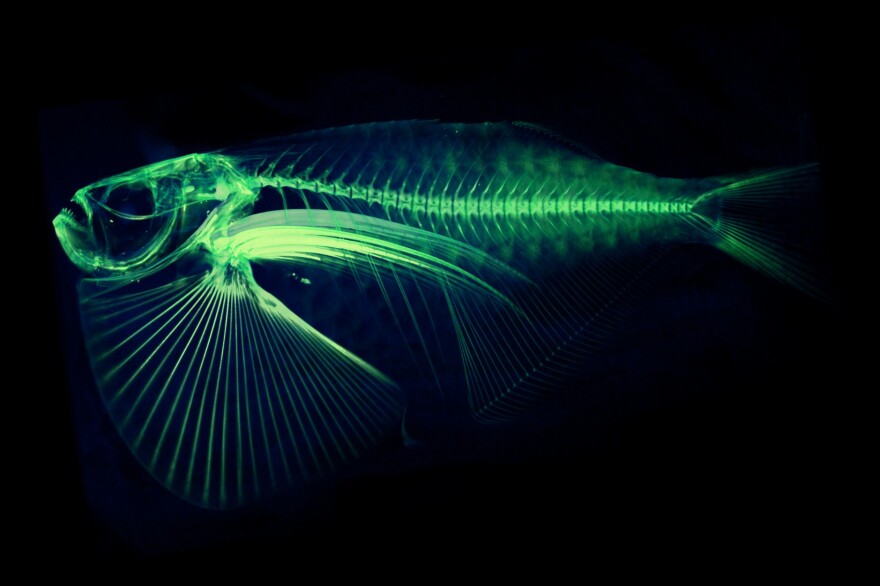In a tiny island laboratory in the northwesternmost corner of Washington, one marine biologist is on a mission: Scan every known fish species in the world.
It’s a painstaking and smelly task, but one that promises to fundamentally change the way scientists and educators look at marine anatomy.
Adam Summers, a fish expert at the University of Washington, has been 3-D scanning fish for decades, but it was always a complicated and expensive undertaking. Getting access to the right equipment was a struggle, and each specimen would take nearly a day to process.
In late 2015, Friday Harbor Laboratories on San Juan Island acquired its own computed tomography scanner, and Summers’ team set out to achieve what had once seemed impossible: to create 3-D models of all 33,000 known fish species.
The technology Summers uses to create three-dimensional images of fish skeletons is a much smaller version of the same machine used in hospitals to do CT scans on humans. For decades, his method for scanning fish was much the same as that of the hospital radiology lab.
But while one subject per scan is well and fine for humans, Summers soon realized dead fish aren’t quite so picky.
“The big innovation here was the idea to do lots of species at the same time,” Summers said. “We package as many as 20 species of fishes all at once into a sort of fish burrito and put them in the micro CT scanner and get data from all of them all at once.”

This fish burrito, a small gauze bundle of ethanol-soaked fish, is what makes Summers’ goal of scanning all 33,000 fish species remotely possible. Whereas scanning each fish individually would take one researcher more than a lifetime, Summers now estimates that he can scan 33,000 fish in two to three years.
“Since I’ve started scanning, I’ve scanned three times as many fish in the last few months, as I’d scanned in the previous 15 years,” Summers said. “This amount of information is absolutely startling and it really does represent a huge increase in the body of knowledge about one of the most diverse and important group of vertebrates on the planet.”
The fish that Summers scans are archival specimens, shipped to his lab from museums all over the world. After Summers creates his digital image, each fish is returned to these museums for future scientific reference.
But Summers is not content to let his 3-D models sit idle in an academic catalog. Instead, he’s making all of his scans available online for free.
“If you’re a teacher in high school, you can download a few different fishes and 3-D print them, so that students can see as big as their heads the difference between different lineages,” Summers said. “If you’re a toymaker and you desperately want to make a mobile for a baby that’s actual fish skeletons, you can download that and print yourself some fish skeletons and make millions.”

David Blackburn, curator for the Florida Museum of Natural History, is one of several scientists working alongside Summers to grow this collection of digital vertebrates. Blackburn specializes in the study of reptiles and amphibians and has scanned representatives from nearly all of the 57 frog families. Part of Blackburn’s job is making the museum’s collection available to the public and the scientific community. For him, this kind of access to online 3-D scans is already changing the way people interact with scientific data.
“It may be that a specimen has sat on our shelves for 30 years and we’ve looked at it and said, ‘Ah, that looks cool,’ but literally nobody has showed up to use it,” Blackburn said. “Suddenly this whole community of people that would simply never have knocked on our door are using these things in their classrooms around the world.”
For Doug Boyer, a paleobiologist at Duke University and curator of the word’s largest virtual museum of 3-D vertebrate models, these fish and frog specimens are only the beginning.
“You can imagine if we have researchers like Dr. Summers and Blackburn contributing their data sets,” Boyer said, “we could pretty quickly have a very substantial representation of the world’s anatomical diversity up on this site.”
Blackburn, Summers and Boyer are part of a growing consortium of scientists and universities that are attempting large-scale 3-D scanning efforts. Their goal is to one day have scans of everything from bullfrogs to whale sharks available for downloading and digital dissection.
Just a few thousand more fish burritos to go.
EarthFix is a public media partnership of Oregon Public Broadcasting, Idaho Public Television, KCTS9 Seattle, KUOW Puget Sound Public Radio, Northwest Public Radio and Television, Jefferson Public Radio, KLCC and the Corporation for Public Broadcasting. EarthFix also is a partner of Innovation Trail.


